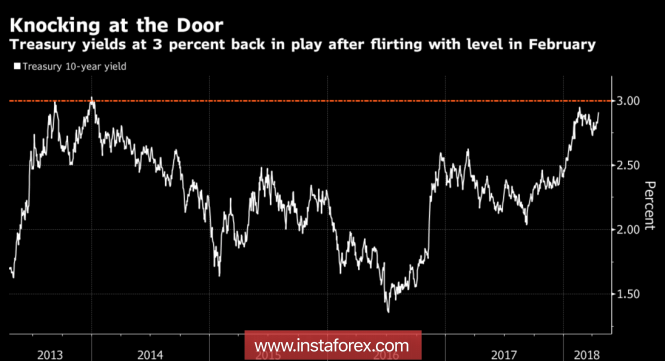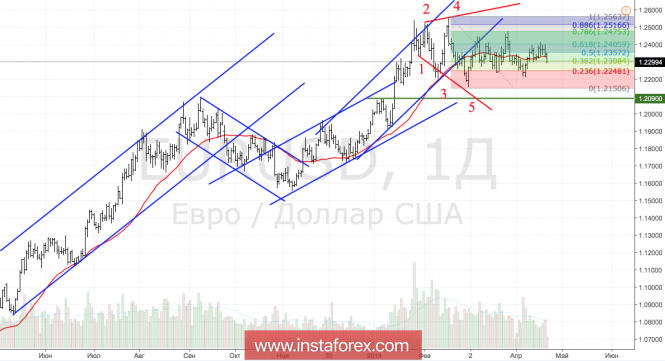The positive macroeconomic statistics for the US, the "hawkish" rhetoric of the Fed, the probability of three increases in the federal funds rate in 2018 from 69% to 84%, four monetary restrictions from less than 30% to 42%, an increase in the yield of 10-year Treasury bonds up to 2.93%, the maximum mark since February, and finally, the expectations of the peaceful rhetoric of Mario Draghi at a press conference following the upcoming ECB meeting, what could be the best background for the bears' attack on EUR / USD? Dozing almost the whole week by April 20, the main currency pair at the end of it was quickened and confidently went down.
Dynamics of the yield of US Treasury bonds

Theoretically, the divergence factor in monetary policy works as follows. An increase in the chances of a monetary restriction of the Fed, coupled with the ECB's leisureliness lead to an expansion of the yield differential between US and German bonds. The attractiveness of securities issued in the US is growing, which contributes to the flow of capital from the Old to the New World. The problem is that when investing money in the US bond market, Europeans hedge their currency risks by selling dollars. And the cost of such insurance reaches 2.3% -2.4%. I mean, in order for American bonds to look better than German bonds, the rate on them should tend to 3% or exceed this mark. It seems that the market believes that everything will happen, and starts buying the USD index.
The situation is exacerbated by low risks of hawks from the ECB following the meeting of the Governing Council scheduled for April 26. Sluggish inflation in the eurozone (+ 1.3% y / y in March), weak statistics on industrial production, retail sales, and business activity make the Central Bank think three times before normalizing monetary policy. Yes, ECB representatives consider the GDP block down in the currency block in the first quarter as a temporary phenomenon, the IMF is full of optimism and raises the forecast for economic growth in 2018 from 2.3% to 2.4%, but without improving the ECB statistics, nothing will happen.
Let us recall that in 2017, key drivers of the euro strengthening against major world currencies were a decrease in political risks, a rapid growth of the eurozone's GDP, rumors about the normalization of the monetary policy of the European Central Bank and capital flow to the Old World securities market. At least two of them do not work this year. Hence the weakness of the "bulls" for EUR / USD, yet unable to restore an uptrend.
Another thing is that the dollar can not boast of something serious. The normalization of the monetary policy of the Fed is at the end of the cycle, and in such circumstances, investors calmly react to an additional increase in the rate for federal funds. It is obvious that the Federal Reserve will bring it to 3%. The limit is known, you can switch to the monetary policy of the central banks-competitors.
Technically, the consolidation in the range of 1.22215-1.2475 within the "Expanding wedge" pattern continues. The breakthrough of its upper limit will strengthen the risks of recovery of the uptrend.
EUR / USD, the daily chart


No comments:
Post a Comment